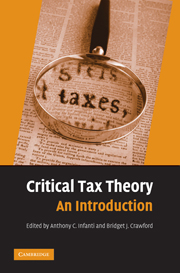Book contents
- Frontmatter
- Contents
- List of Illustrations
- List of Tables
- List of Contributors
- List of Common Abbreviations
- Introduction
- CHAPTER 1 FOUNDATIONS OF CRITICAL TAX THEORY
- CHAPTER 2 HISTORICAL PERSPECTIVES ON TAXATION
- CHAPTER 3 THE GOALS OF TAX POLICY
- CHAPTER 4 CRITICAL TAX THEORY MEETS PRACTICE
- CHAPTER 5 RACE AND TAXATION
- Tax Counts: Bringing Money-Law to LatCrit
- A Black Critique of the Internal Revenue Code
- The Marriage Bonus/Penalty in Black and White
- Tax and Race: The Impact on Asian Americans
- Race and Equality Across the Law School Curriculum: The Law of Tax Exemption
- Race and Class Matters in Tax Policy
- CHAPTER 6 GENDER AND TAXATION
- CHAPTER 7 SEXUAL ORIENTATION AND TAXATION
- CHAPTER 8 THE FAMILY AND TAXATION
- CHAPTER 9 CLASS AND TAXATION
- CHAPTER 10 DISABILITY AND TAXATION
- CHAPTER 11 GLOBAL CRITICAL PERSPECTIVES ON TAXATION
- CHAPTER 12 CRITICAL PERSPECTIVES ON CRITICAL TAX THEORY
- Index
The Marriage Bonus/Penalty in Black and White
Published online by Cambridge University Press: 04 August 2010
- Frontmatter
- Contents
- List of Illustrations
- List of Tables
- List of Contributors
- List of Common Abbreviations
- Introduction
- CHAPTER 1 FOUNDATIONS OF CRITICAL TAX THEORY
- CHAPTER 2 HISTORICAL PERSPECTIVES ON TAXATION
- CHAPTER 3 THE GOALS OF TAX POLICY
- CHAPTER 4 CRITICAL TAX THEORY MEETS PRACTICE
- CHAPTER 5 RACE AND TAXATION
- Tax Counts: Bringing Money-Law to LatCrit
- A Black Critique of the Internal Revenue Code
- The Marriage Bonus/Penalty in Black and White
- Tax and Race: The Impact on Asian Americans
- Race and Equality Across the Law School Curriculum: The Law of Tax Exemption
- Race and Class Matters in Tax Policy
- CHAPTER 6 GENDER AND TAXATION
- CHAPTER 7 SEXUAL ORIENTATION AND TAXATION
- CHAPTER 8 THE FAMILY AND TAXATION
- CHAPTER 9 CLASS AND TAXATION
- CHAPTER 10 DISABILITY AND TAXATION
- CHAPTER 11 GLOBAL CRITICAL PERSPECTIVES ON TAXATION
- CHAPTER 12 CRITICAL PERSPECTIVES ON CRITICAL TAX THEORY
- Index
Summary
A marriage penalty occurs whenever a couple pays higher federal income taxes as a result of their marriage than they would pay if they remained single and filed individual returns. A marriage bonus occurs whenever a couple pays lower federal income taxes as a result of marriage than they would pay if they remained single and filed individual returns. Marriage penalties are the greatest where there are two wage earners; marriage bonuses are the greatest where there is only one wage earner. Although numerous articles have been written about the marriage penalty, this essay provides a different perspective.
THE TAX IMPLICATIONS OF THE MARRIAGE DECISION
This section considers the effects of the marriage decision by examining the differences between white and black households. The evidence suggests that there is a difference in the impact of both the marriage bonus and the marriage penalty based upon race. Black families are more likely to pay a marriage penalty; white families are more likely to receive a marriage bonus.
My analysis is limited to an investigation of the differences between black and white households. Without question, a richer, more complete examination ultimately must include Hispanic, Asian, Native American, and other racial or ethnic groups. In that regard, this essay is intended only as a first step in considering the racial and gender implications of the rate structure. This essay also makes the simplifying assumption that there are no racially mixed households. That assumption does not distort the picture much, given that in 1985, 98.9% of black married women and 96.6% of black married men had a black spouse.
- Type
- Chapter
- Information
- Critical Tax TheoryAn Introduction, pp. 125 - 129Publisher: Cambridge University PressPrint publication year: 2009
- 3
- Cited by



